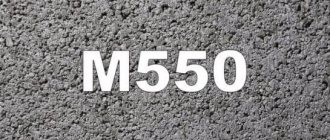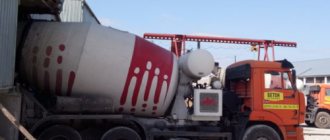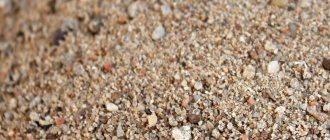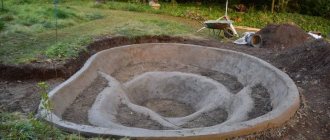When performing construction work, a concrete solution is used. This material is created on the basis of a binder component, sand and additives that promote strength and other performance properties. Due to the affordable price, reliability and ease of creating concrete, anyone can prepare it.
general information
Lightweight concrete began to appear in the construction industry relatively recently. Despite this, it quickly gained great popularity and became widely used for a wide variety of tasks. Today, based on such raw materials, high-quality buildings for various purposes are created.
Thanks to its significant advantages, lightweight concrete allows you to achieve better acoustic and thermal insulation performance during the construction of premises, and its minimal weight guarantees significant cost savings and a reduction in the final cost of the project.
Currently, the material is especially in demand in difficult conditions with high seismic activity, since heavy concrete cannot be used in such places.
The innovative building material can be used in the construction of thermal insulation and load-bearing structures, as well as play a decorative role. With its help, you can achieve a reduction in the overall load on the foundation and a reduction in financial costs for labor and delivery of material to the site. In terms of thermal insulation quality, it is in no way inferior to classic brick, and at the same time costs much less. The advantages of the material also include:
- Moisture resistance.
- Frost resistance.
- Excellent density.
Selection of concrete mortar composition and mixing.
Despite the similar designations, the grade of concrete and the grade of cement are completely different concepts. The number in the cement grade indicates the strength of the cement mortar.
Since the design of the foundation involves its reinforcement in order to ensure lateral strength, it is optimal to choose crushed stone or gravel of the middle fraction. Crushed granite gravel provides the best traction.
As for sand, in theory it is recommended to use sea sand, but regular sand from a sand quarry will do. It is important to note that the sand should be pre-strained to remove clay and other unwanted inclusions.
What concrete is best to use for a strip foundation?
There are no special requirements for water; ordinary tap water will do. The cement-water ratio is 2:1.
The preferred method is to use a concrete mixer, but manual mechanical mixing of the solution is also possible. To do this, you will need a volumetric container into which sand, gravel or crushed stone and cement are added in a certain ratio. After mixing the dry ingredients well, you can gradually add water, stirring constantly until a homogeneous mass is formed. It is important not to overdo it with the amount of water.
Main types of lightweight concrete
Experienced builders know that high-quality material meets all state standards, while according to GOST 25192 it can have a different structure. Depending on this characteristic, concrete can be:
- Dense . The material contains small and large particles, an astringent component and liquid, which create a thick consistency and completely fill the voids. The air content inside the composition does not exceed six percent.
- Large porous . The binder components of this concrete are capable of enveloping the aggregate grains, while the air content is equal to ¼ of the total volume. To achieve better thermal insulation, wall structures must be treated with plaster on both sides.
- Cellular . It has low density and poor thermal conductivity. The pores of this concrete resemble small cells in the shape of a sphere, the diameter of which is 1-3 millimeters. Among the advantages of the variety are low weight but excellent strength. In addition, the material does not require complex installation and is very cheap, which allows us to call it the most suitable building material for erecting walls and carrying out roofing work.
When choosing a suitable brand of concrete, you need to make sure that it complies with the state GOST standard. In addition, the products must remain environmentally friendly and not contain harmful components.
The main component of concrete is crushed stone, which is often diluted with limestone, dolomite and other particles. The name of the material depends on the type of filler, so modern craftsmen distinguish:
- Slag concrete.
- Expanded clay concrete.
- Pumice concrete.
- Agloporite concrete.
- Perlite concrete.
- Azerite concrete.
- Vermiculite concrete.
- Thermozitic concrete.
And several other varieties.
The material can contain both mineral and organic binder components. In the first case it is:
- Cement.
- Lime.
- Liquid glass.
- Lime.
- Mixed particles.
Also, the grades of concrete available on the market can be divided depending on their purpose. There are these types:
- Structural. They are characterized by low density, which is 1400-1800 kg/cm3, with strength indicators from M50 and frost resistance F 15.
- Structural and thermal insulation. The density of lightweight concrete of this type is 500-1400 kg/m3, and the strength is not lower than M35. Most often this variety is used for load-bearing structures.
- Thermal insulation. They have an average density in an air-dry state. On their basis, thermal insulation boards and many other useful elements are created.
- Heat resistant. Used in extreme conditions with abnormally high ambient temperatures or a high risk of ignition.
- Chemical-resistant. Effective in plants and factories where work with chemicals is carried out.
Workability, mobility, cone draft (P)
These three concepts, in principle, describe the same concrete characteristic, which is denoted by the letter P with a coefficient from 1 to 5, or as “cone slump 10-15 cm.” For standard monolithic work, concrete with mobility P-2 and P-3 is used. For difficult-to-fill structures, such as columns, narrow formworks and densely reinforced cavities, it is advisable to use concrete P-4 and higher (cone draft 16-21 cm). This type of concrete is called cast concrete; it fits well into formwork without the use of a vibrator.
Concrete stiffness (denoted by the letters Zh1-Zh4) is a characteristic related to concrete used mainly in road construction.
Under no circumstances should water be added to concrete to increase its mobility, since, as mentioned above, the water-cement ratio is a key proportion on which the strength of concrete depends. Even due to a slight increase in the amount of water in the mixture, the grade of concrete can decrease from m-400 to m-300-m-200. To increase the mobility of the mixture to indicators P4, P5, PSK STROYTECH uses plasticizers - this is the only sure way to produce cast concrete intended for laying in formwork with a dense frame of reinforcement, or for monolithic work using a concrete pump.
Porous material
It's no secret that one of the most popular materials for modern construction is lightweight concrete. The composition of such a product is selected depending on the type and complexity of the work to be performed.
And among the above varieties, porous materials are especially popular.
In addition to frost resistance and a long service life, the raw materials remain resistant to moisture and are relatively inexpensive. In addition, it consists of mineral components, which guarantees compliance with all modern norms and environmental standards. It is these properties that make porous concrete very popular and in demand for construction.
It should be noted that the prototype of the porous material was used in ancient Rome several thousand years ago. It was created from natural ingredients, such as pumice, ceramics or clay from dishes.
However, the material began to be in wide demand only in the second half of the 20th century, when artificial fillers appeared on the market, including expanded clay, slag pumice, etc. Currently, both natural and artificial components are used. And if the first is pumice, lava, limestone or rocks, then the second is a complex porous product that is created on the basis of natural materials with the addition of chemical additives. Artificial fillers can have different bulk densities, strength and grain composition, moisture and frost resistance.
What is better to use – crushed stone or gravel?
Aggregates are of great importance in the composition of construction concrete. What is better to use crushed stone or gravel can be found out by comparing the physical properties. The external similarity of the substances is noted; both were obtained by artificial and natural crushing of rocks.
Crushed stone is a fraction of stone, 5-6 mm in size. Gravel, fragments of rock, can be glacial, marine, river or lake in origin. Gravel has loamy additives, so crushed stone is better suited for making a strong concrete mixture.
Its uneven surface, shape, ability to spread evenly and bind to cement make it the best aggregate. Suitable size 20mm. Using crushed stone of different sizes will reduce voids in the finished product.
Crushed stone should not contain radioactive, dust, or clay compounds.
Properties of aerated concrete
The use of lightweight concrete in construction has been known since ancient Rome. However, the material received its current form after many years of research and many changes. Modern aerated concrete is created from a cement mixture with the addition of lime, a siliceous component and liquid, which is introduced into an already mixed mixture of a gas-forming agent - aluminum powder, perhydrol, etc.
Only one aluminum powder can be used. The creation of the gas is accomplished by chemical contact of aluminum with calcium hydroxide. The release of hydrogen causes swelling of the cement, as a result of which it hardens, but retains its characteristic cellularity.
The initial components of aerated concrete include cement, lime, ground sand and water. All components are thoroughly mixed with each other in a special container, after which the solution is diluted with aluminum powder and stirred again.
Ultimately, the resulting consistency must be poured into a metal mold and filled completely.
After waiting for the aerated concrete to mature, it must be further processed in actoclaves for accelerated hardening. The autoclave processing method guarantees maximum strength of the final product, and also reduces cement costs due to complete or partial replacement with lime.
Due to its low cost, minimal weight and many other advantages, aerated concrete is considered an extremely popular building material, without which it is difficult to imagine modern construction. The scope of application of raw materials is very wide, since aerated concrete can be used for the construction of houses, for arranging walls, and for solving various decorative problems.
Useful tips
Finally, a few tips. Maybe some of them will also be useful to you.
- Create suitable conditions for kneading. Temperatures below zero are bad for concrete. If there is no choice, use appropriate additives and heat the water to mix the solution.
- Wet the walls of the trough in which you will mix the concrete. Then the dry ingredients will not settle on them.
- If you use the manual method, you can also make your task easier by buying a mixer attachment for a drill.
- Incorporating fiber into concrete helps further enhance its strength.
- Many people overlook the quality of water and sand. Some impurities, such as clay, interfere with the curing reaction of concrete.
You can buy ready-made construction mixture, but why, if you can knead it with your own hands right on the site. It will be cheaper. Moreover, if everything is done according to our instructions, the quality of such concrete will be no worse than that which will be brought to you from the factory. Give it a try, it's always nice to make something from scratch. At least, you yourself will control every stage of construction.
And if you have already tried it, then share your secrets of a good mixture in the comments. Maybe you have your own ways to simplify the process of preparing the solution?
Subtleties of production technology
As is known, the technology for producing light weight concrete differs significantly from the production of heavy concrete. To create a high-quality product, the porous element must be placed in dry conditions where there is no moisture. In this case, the fractions should not be mixed, but separate. Otherwise, the composition of the product will differ from the required one.
It is also important to transport the aggregates carefully to the production site. Any disruption, moisture penetration or mixing will significantly damage the consistency. In most cases, light mixtures are created in specialized mixers, where the possibility of separation of the components is eliminated. Water is continuously supplied to the container until loading is complete. The mixing time is determined by the operation of the mixer, the speed of rotation and the density of the mixture.
Vibration technology is used to compact the structure. It is through vibration that the material acquires one unique feature. At the end, the light grains float to the top, and the cement ends up at the bottom.
Products made from the described building material can often be further processed in an environment with saturated steam. To speed up the hardening of concrete, it is better to use steamless heating in an environment with low humidity. It is this approach that guarantees complete purification of the material from moisture without compromising the strength characteristics.
How to do it yourself?
The process depends on the type of solution: it is almost impossible to prepare foam concrete at home, but mixtures with expanded clay or light porous additives are quite possible. The main problem concerns the choice of the W/C ratio; most aggregates are rough and absorbent. Therefore, the proportions are selected experimentally, a small portion is mixed, a test sample is poured and aged. The easiest way to prepare lightweight concrete with your own hands is based on expanded clay: pour water into a concrete mixer, add cement in portions (until it becomes milky) and only then filler, all components are mixed until homogeneous.
When kneading at home, there is a constant risk of uneven distribution of the binder. For this reason, any modifiers are simply added to the water at the beginning of the batch (and not at the end, as with heavy concrete). The exception is fiber fiber; it is introduced into the composition last. Porous thermal insulation fillers require pre-wetting (such as perlite or vermiculite). Manual mixing is not recommended; if you do not have a concrete mixer, you should use a drill or construction mixer. Lightweight porous concrete retains its structure well and is optimal for using slip formwork technology; the final strength gain depends on the composition.
Advantages of buildings
As is known, lightweight concrete differs from heavy material by the presence of small and large pores in the filler grains. It is inferior in strength to cement stone, but due to its specific structure it demonstrates excellent adhesion.
When choosing a building material, it is important to pay attention to its density. The fact is that this parameter is one of the primary indicators of quality. Moreover, density indicators vary depending on the state of the material. So in a dry state they are different than in a wet state. The main factors affecting density are:
- Permeability.
- Thermal conductivity.
- Strength.
There are many grades of concrete available on the market: from D200 to D2000.
As for reliability, it is determined by the quality of the raw materials and solidification conditions. If you add porous components to concrete, this will have a bad effect on strength. Also, the presence of coarse aggregate with a porous structure in the composition plays a special role.
In terms of water resistance and resistance to frost, lightweight concrete is not inferior to ordinary concrete. However, it costs much less than its classic brother. According to information from the manufacturer, the frost resistance of lightweight concrete varies in the range F 25-F 100. For extreme climatic conditions, grades with indicators F 200, F 300, F 400 are produced.
As for resistance to moisture, it is indicated by the letter W. Today on sale you can find the following brands: WO 2, WO 4, WO 6, WO 8, W 1, W 1.2.
According to the builders, when constructing wall structures from lightweight concrete, labor costs are reduced by 20 times, and the cost of the future project becomes 30% cheaper. Among the advantages of such materials for walls are:
- Environmental cleanliness and compliance with all cleanliness and safety requirements.
- Minimum weight.
- Plastic.
- Beautiful appearance, allowing the use of concrete for decorative wall decoration.
- Resistance to moisture, due to which the material is widely used for the construction of baths.
- Fire resistance and frost resistance.
Amount of water for different degrees of plasticity
When preparing a concrete mixture, liquid is added according to the norm. Both excess and insufficient moisture are harmful to the finished product.
Table No. 2 Water norm in liters per cubic meter with different fillers
| Plastic | Water with gravel (l.) | Water with crushed stone (l.) | ||||||
| Material fraction, mm (gravel) | Material fraction, mm (crushed stone) | |||||||
| 10 | 20 | 40 | 80 | 10 | 20 | 40 | 80 | |
| Maximum | 214 | 199 | 184 | 169 | 229 | 214 | 199 | 184 |
| Average | 204 | 189 | 174 | 159 | 219 | 204 | 189 | 174 |
| Minimum | 194 | 179 | 164 | 149 | 209 | 194 | 179 | 164 |
| Not plastic | 184 | 169 | 154 | 139 | 199 | 184 | 169 | 154 |
The plasticity of a material in everyday life can be determined by a simple test. Very plastic concrete flows easily from a shovel if the mixture floats when the tool is slightly tilted - this is medium-plastic concrete.
With low plasticity, the concrete mixture will not flow even with a strong slope. Material lying in a dense pile on a shovel is considered to have no plasticity.
Application in construction and decoration
Recently, lightweight materials have begun to be actively used for decorative elements. With their help, you can decorate a beautiful arch or columns in the Greek style, frame windows, or perform any other decorative task.
With the right approach, almost anything can be made from the material, including the most bizarre designs of designers. In addition, you can complete most tasks yourself, since there are no difficulties.
Without a doubt, lightweight concrete is a unique material that has virtually no competitors on the market. In a short period of time, you can build a full-fledged structure from this material, as well as turn the decor into a real work of art.
Flaws
The trump card of lightweight concrete is considered to be specially created pores, which give them the above-mentioned positive properties. However, they also cause the disadvantages of blocks:
- less strength compared to traditional, heavy materials;
- higher level of moisture absorption. It penetrates precisely through artificially created voids. Therefore, plastering of external and internal surfaces is strongly recommended.
Return to contents
Forced action concrete mixer and gravity unit
There are no fundamental differences in the order of mixing the solution in these machines. The only difference is in the operating principle of the units. The forced one actively mixes with blades, and the gravitational one uses the rotation of the drum itself and the force of universal gravity.
The main thing here is to take the right time. The forced one does its job 2 times faster.
The forced-type concrete mixer has different sizes and modifications:
- rotary;
- cascade:
- planetary.
How to properly mix concrete in a concrete mixer - step-by-step diagram
Step 1: Installation of concrete mixer
Step 2: Download Components
Step 3: Mixing
Step 4: Unloading concrete and cleaning the unit
- Author: Manager Andrey
(7 votes, average: 4.3 out of 5)
To solve this problem, there are special counting methods. We will turn to them.
The most common grades of cement are M400 and M500. Sand is best used with grains no larger than 2.5 mm in diameter. Crushed stone is used in fractions of 5-20 mm.
For the above parameters we will provide the necessary numbers.
Number of components for preparing a cubic meter of concrete
So, the following amount of materials will be required. If you use M400 cement, then for 1m3 of concrete you need:
- 338 kg cement
- 642 kg sand
- 1250 kg crushed stone
- 170 l water
If the cement is grade M500, then you will need:
- 292 kg cement
- 702 kg sand
- 1258 kg crushed stone
- 146 liters of water
After translation, the following values were obtained.
When using M400 cement you need:
- 281 liters of cement
- 445 l sand
- 781 l crushed stone
When using cement M500 it is necessary:
- 243 liters of cement
- 487 l sand
- 786 l crushed stone
Number of components for volume-specific concrete mixers in buckets
70 l concrete mixer
For cement M400:
- Cement - 1.1
- Sand - 1.8
- Crushed stone - 3.1
- Water - 0.7
For cement M500
- Cement - 1
- Sand - 2
- Crushed stone - 3.1
- Water - 0.6
Concrete mixer 100 l
For cement M400:
- Cement - 1.5
- Sand - 2.5
- Crushed stone - 4.3
- Water - 1
For cement M500
- Cement - 1.3
- Sand - 2.7
- Crushed stone - 4.3
- Water - 0.8
Concrete mixer 120 l
For cement M400:
- Cement - 1.8
- Sand - 3
- Crushed stone - 5
- Water - 1.1
For cement M500
- Cement - 1.6
- Sand - 3.2
- Crushed stone - 5
- Water - 1
Concrete mixer 140 l
For cement M400:
- Cement - 2.2
- Sand - 3.5
- Crushed stone - 6
- Water - 1.3
For cement M500
- Cement - 1.8
- Sand - 3.7
- Crushed stone - 6
- Water - 1.1
Concrete mixer 160 l
For cement M400:
- Cement - 2.5
- Sand - 4
- Crushed stone - 7
- Water - 1.5
For cement M500
- Cement - 2.1
- Sand - 4.3
- Crushed stone - 7
- Water - 1.3
Concrete mixer 180 l
For cement M400:
- Cement - 2.8
- Sand - 4.5
- Crushed stone - 7.7
- Water - 1.7
For cement M500
- Cement - 2.5
- Sand - 4.8
- Crushed stone - 7.8
- Water - 1.5
Concrete mixer 200 l
For cement M400:
- Cement - 3
- Sand – 5
- Crushed stone - 8.5
- Water - 1.9
For cement M500
- Cement - 2.7
- Sand - 5.5
- Crushed stone - 8.7
- Water - 1.6
Concrete mixer 220 l
For cement M400:
- Cement - 3.5
- Sand - 5.3
- Crushed stone - 9.5
- Water - 2
For cement M500
- Cement - 3
- Sand - 6
- Crushed stone - 9.5
- Water - 1.8
Concrete mixer 250 l
For cement M400:
- Cement - 3.8
- Sand - 6.1
- Crushed stone - 10.7
- Water - 2.3
For cement M500
- Cement - 3.3
- Sand - 6.7
- Crushed stone - 10.8
- Water - 2











